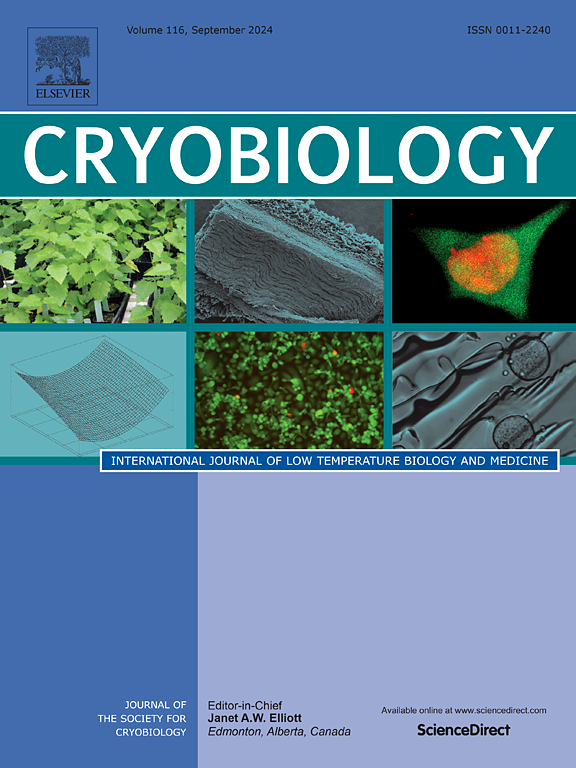低温玻璃化法对山羊体外胚胎冷冻保存的影响
IF 2.1
3区 生物学
Q2 BIOLOGY
引用次数: 0
摘要
研究了胚胎发育阶段、冷冻保护剂浓度和玻璃化液体积对山羊体外胚胎冷冻保存效率的影响。实验1体外受精后冷冻保存20 h的受精卵存活率低于体外受精后冷冻保存7 d的囊胚存活率(66.86% vs 90.92%, P < 0.05)。受精卵组的卵裂率和囊胚率均低于对照组(非冷冻)(分别为52.91%和81.94% vs 81.94%和36.48%,P < 0.05)。玻璃化囊胚和受精卵的囊胚孵化率分别为14.62%和3.69%。实验2中,16.5% EG + 16.5% DMSO组玻璃化囊胚的存活率高于12.5% EG + 12.5% DMSO和20% EG + 20% DMSO组(分别为91.34%比43.16%和61.24%,P < 0.05)。12.5% EG + 12.5% DMSO、16.5% EG + 16.5% DMSO和20% EG + 20% DMSO组的囊胚孵化率为0%;分别为13.74%和0%。实验3中,0.3 μL、0.5 μL和1 μL玻璃化的囊胚存活率差异无统计学意义(P > 0.05)。0.3 μL浓度组的囊胚孵化率高于0.5 μL和1 μL浓度组(分别为44.18%比13.98%和14.36%,P < 0.05)。综上所述,在CPA浓度为16.5% EG + 16.5% DMSO,玻璃化液体积为0.3 μL的条件下,采用低温玻璃化法成功地玻璃化了IVP山羊胚胎。本文章由计算机程序翻译,如有差异,请以英文原文为准。
Effects of the cryotop vitrification method for the cryopreservation of in vitro produced Cỏ goat embryos
This study investigated the influence of embryonic developmental stage, cryoprotectant concentration, and vitrification solution volume on the cryopreservation efficiency of in vitro-produced Cỏ goat embryos. In Experiment 1 the survival rate of zygotes cryopreserved 20 h after IVF was lower than blastocysts cryopreserved 7 days after IVF (66.86 % vs 90.92 %, P < 0.05). The cleavage and blastocyst rates of the zygote group were lower than those of the control (non-cryopreserved) group (52.91 % and 81.94 % vs 81.94 % and 36.48 %, respectively, P < 0.05). The hatching blastocyst rate achieved by embryos vitrified as blastocyst or zygotes was 14.62 % and 3.69 %, respectively. In Experiment 2, the survival rate of blastocysts vitrified in the 16.5 % EG + 16.5 % DMSO group was higher than that of the 12.5 % EG + 12.5 % DMSO and 20 % EG + 20 % DMSO groups (91.34 % vs 43.16 % and 61.24 %, respectively, P < 0.05). The hatching blastocyst rate of 12.5 % EG + 12.5 % DMSO, 16.5 % EG + 16.5 % DMSO and 20 % EG + 20 % DMSO groups was 0 %; 13.74 % and 0 %, respectively. In Experiment 3, the difference in the survival rate between blastocysts vitrified in 0.3 μL, 0.5 μL and 1 μL was not statistically significant (P > 0.05). The hatching blastocyst rate of the 0.3 μL group was higher than that of the 0.5 μL and 1 μL groups (44.18 % vs 13.98 % and 14.36 %, respectively, P < 0.05). In conclusion, the IVP Cỏ goat embryos were successfully vitrified by cryotop vitrification method at a CPA concentration of 16.5 % EG + 16.5 % DMSO with a vitrification solution volume of 0.3 μL.
求助全文
通过发布文献求助,成功后即可免费获取论文全文。
去求助
来源期刊

Cryobiology
生物-生理学
CiteScore
5.40
自引率
7.40%
发文量
71
审稿时长
56 days
期刊介绍:
Cryobiology: International Journal of Low Temperature Biology and Medicine publishes research articles on all aspects of low temperature biology and medicine.
Research Areas include:
• Cryoprotective additives and their pharmacological actions
• Cryosurgery
• Freeze-drying
• Freezing
• Frost hardiness in plants
• Hibernation
• Hypothermia
• Medical applications of reduced temperature
• Perfusion of organs
• All pertinent methodologies
Cryobiology is the official journal of the Society for Cryobiology.
 求助内容:
求助内容: 应助结果提醒方式:
应助结果提醒方式:


